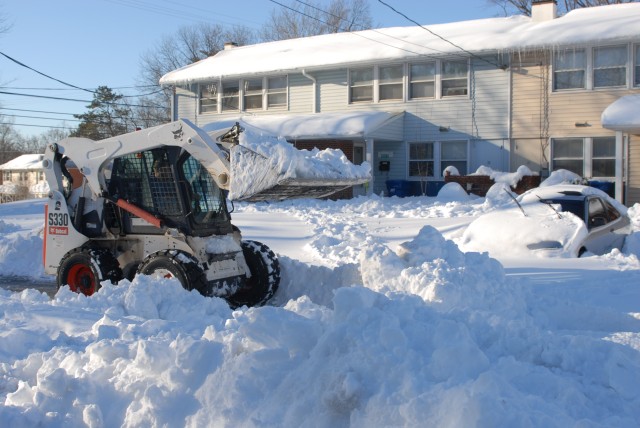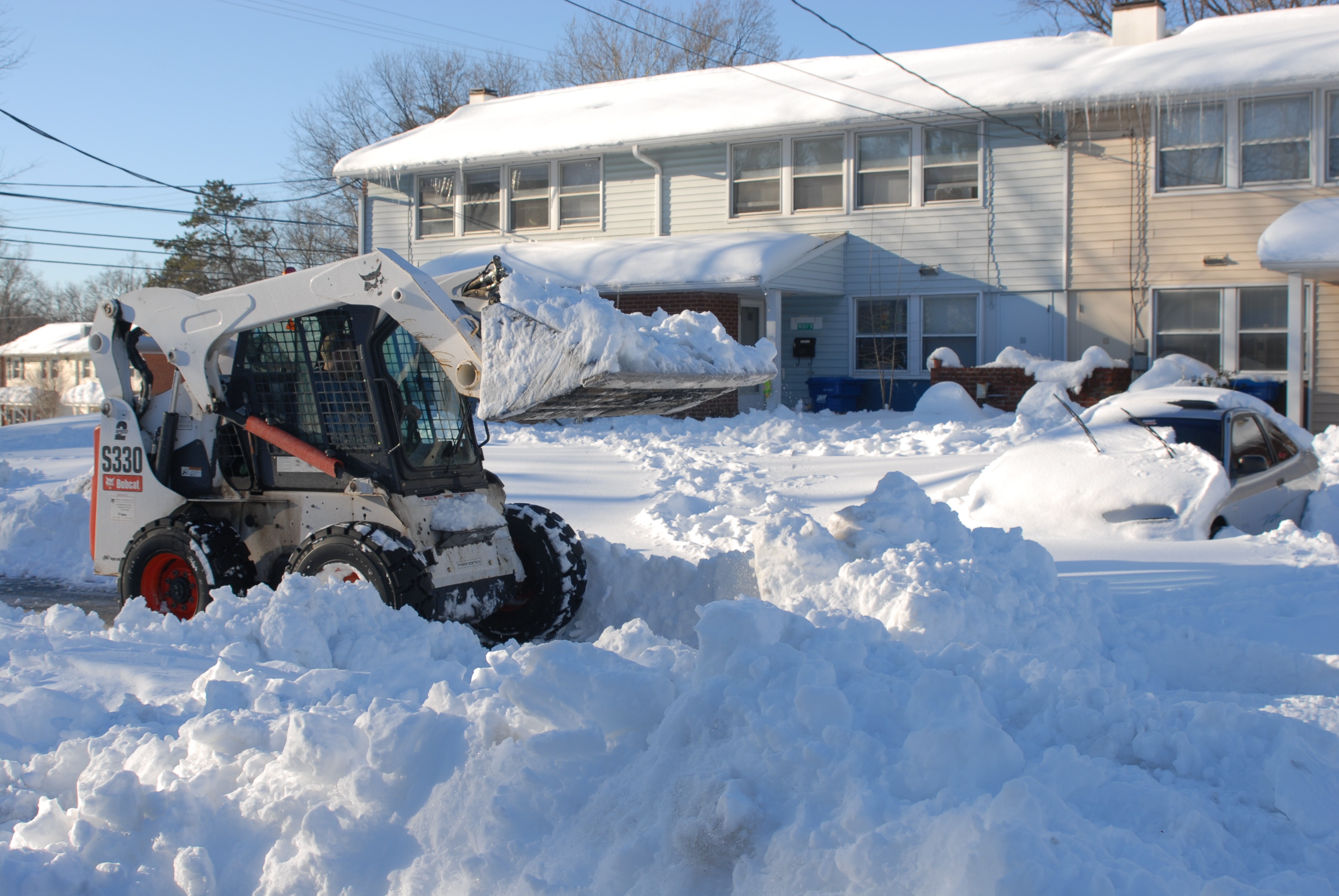
FORT MEADE, Md. - In garrison headquarters, Charles "Chuck" Blocker, manager of the post's Emergency Operations Center, and a team of coworkers had a problem.
After a storm dropped about 28 inches of snow on Fort Meade Feb. 5, the EOC was struggling to figure out how to help a woman living on post whose quarters had lost power. She had a child at home with her who had a heart monitor that was low on power, Blocker said.
With the help of a pair of Fort Meade Police officers, a portable battery charger was rushed to the woman's home, temporarily solving that problem.
Nearly a week after that incident, Blocker is solving a similar problem. Like bookends to a story, they serve as small examples of the many issues that were juggled for the community during a historic, record-setting snowfall, which has cost the installation upwards of $700,000 to date.
The Directorate of Public Works worked around the clock to restore and maintain power and assist with snow removal efforts.
More than 75 percent of the post lost power during the first snow storm as a result of downed power lines, broken cross arms and malfunctioning transformers. DPW guarded against power outages the second time around.
"If you ask Chuck Blocker and the rest of the team in the EOC, they will give much of the credit to community members and their efforts to help neighbors. I absolutely agree," Installation Commander Col. Daniel L. Thomas said. "But the reality is, it was Chuck and the emergency support team that truly battled the results of the storm and provided a modicum of normality. I am proud of all of them."
The nonchalance from Blocker about taking credit for work done during the storms doesn't surprise Joseph Van Meter, assistant fire chief for the Fort Meade Fire Department.
"It's in the tough times that you're defined," he said. "A lot of guys just look at it as, 'that's what we do'."
After the first storm struck, 14 firefighters, Van Meter among them, battled snow banks and snowy roads to answer calls. As power went out across Fort Meade, the fire department experienced a nearly three-fold increase in emergency calls. Many of those additional calls were from homes where carbon monoxide had become a concern as post residents who had lost power began using their gas stoves to generate heat.
With snow covering roads and parking lots, firefighters relied on a pair of sports utility vehicles and a truck to drive to emergencies. Even vehicles with all-wheel drive struggled in the snow, Van Meter said.
"There were several calls where we had to park on the main thoroughfare and walk several dozen if not several hundred feet into the Courts to respond," he said.
Firefighters trudged through the snow with 40 pound medical bags in addition to their regular fire protection gear that weighs about 30 pounds. Those firefighters who started work early on Feb. 5 continued to work a shift that didn't end until Feb. 7.
Even days after the last snowfall, many of the firefighters who worked during these past two weeks are still recovering from sore joints and shoulders.
While the firefighters may not be ones to step forward to grab thanks, Fire Chief E.J. Rouvet said he intends for them to receive recognition for their efforts.
"We [have] no weak links," Rouvet said. "We had guys fighting each other to go out and fight the snow."
People came together offering aid to the post community. At one point while responding to the first storm, a Directorate of Emergency Services ambulance became stuck in the snow on Clark Road, Van Meter said.
"Neighbors came out and started digging [it out]," he said. "They started pushing it from behind and they got out and it went to help at another incident."
A variety of different helpers pitched in to combat the elements. Picerne Military Housing, which manages on-post housing, had about 130 people working during the storm and following the aftermath. Those workers helped clear nearly 21 miles of post roadway and an additional 10 miles worth of sidewalks spread across communities on the installation, said Angela Marcum, Picerne spokeswoman.
Nearly 4,000 hours of cleanup work had been logged by Picerne workers prior to Friday. Workers relied on everything from simple shovels to Bobcat earthmovers and trucks, Marcum said.
"We've been working around the clock," she said.
Cleanup efforts were complicated at their outset for the company. On Feb. 6, Picerne learned that the roof of a storage warehouse it had at 3000 Ernie Pyle Road had collapsed, burying shovels, ice melting materials and salt as well as other supplies.
The past weeks tested not only people, but also quipment. While Fort Meade has a fleet of trucks to help deal with weather emergencies, those vehicles usually handle four to six inches worth of snow. Faced with feet of snow, some vehicles hit their breaking points.
"Usually, in Maryland you don't have a lot of heavy duty equipment because you can't justify it," Blocker said. "At a low point, 30 percent of our equipment was down."
Some of those vehicles were repaired using cannibalized parts from other ones, but other vehicles still awaited replacements parts as of late last week.
Fort Meade's higher headquarters also helped the installation throughout the crisis by providing financial support, Thomas said.
"We also received emergency budgetary support from our higher headquarters at National Capital Region District and Installation Management Command, to contract additional snow removal equipment," Thomas said. "I asked Brig. Gen. Dennis E. Rogers (director, NCR-D) for help four times. Each time he immediately approved our request for a total of more than $90,000."
Despite the vehicles that were down due to the crisis, Fort Meade should be able to handle the rest of the winter, Blocker said.
"The quality of people here are exceptional," Blocker said. "When the call goes out, they'll do what's needed."

Social Sharing